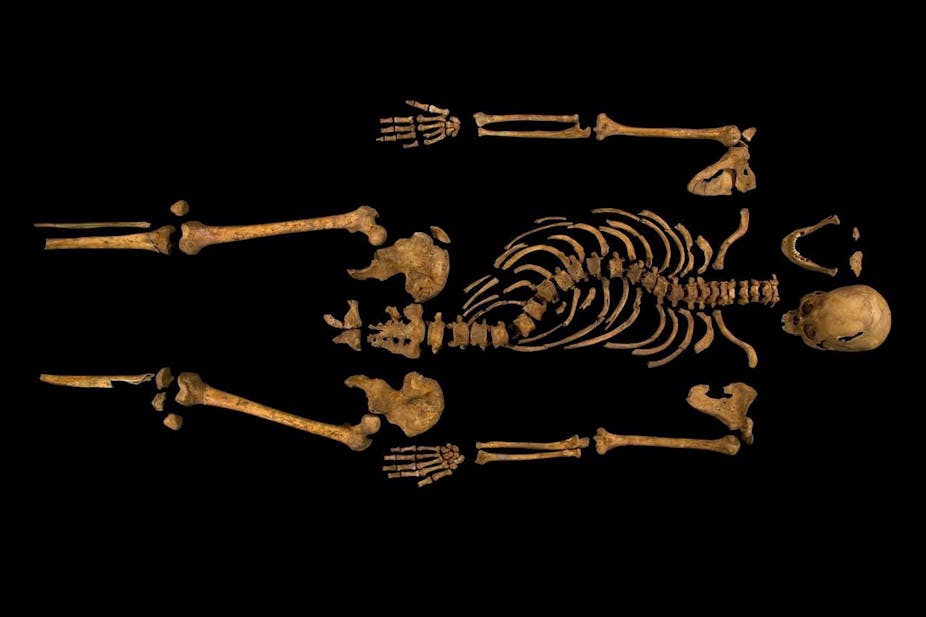“It will be a whole new era for Richard III,” Lynda Pidgeon, spokeswoman for the Richard III Society, said of the discovery that the skeleton found under a car-park in Leicester is almost certainly that of King Richard III. “Hopefully people will have a more open mind toward Richard”, she added.
But why? How will it make people sympathise more with this highly contentious ruler? What does it add to our understanding of his life, death and character? The answer, arguably, is “very little”.
We now know that Richard died of one or more slashes to the skull with a heavy blade, and was also wounded by an arrow. But contemporary writings already confirmed that he died in the battle of Bosworth, and no one familiar with medieval warfare could suppose it was from a light tap on the shoulder. The skeleton shows pronounced scoliosis; this may help to quell exaggerated claims of Tudor writers that Richard was hopelessly deformed, but is perfectly consistent with John Rous’s account (written within seven years of Richard’s death) that he was “small of stature with … unequal shoulders, the right higher and the left lower”.

Evidence of post-mortem wounds to the body suggests that the body was humiliated after death. That’s hardly news. One contemporary London chronicler, generally reasonably reliable, says that Richard’s corpse was displayed stripped naked and trussed on horseback “like a hog, or any other foul beast”. However horrifying to modern sensibilities, this hardly surprises medievalists.
Corpses of deceased kings were not infrequently displayed in public, in part to convince would-be supporters of the certainty of their death. The body of a defeated king like Richard, accused in his lifetime of wife-murder, nephew-assassination and attempted incest, could easily be seen to deserve further ritual humiliation, signalling to onlookers the moral turpitude that “justified” his overthrow.
What these bones cannot tell us is anything decisive about the issues that radically divide Richard’s modern public between those who see him as a martyr to Tudor black-washing, and those who place him on the shady side even of the robust politics of his day.
There’s no DNA test to prove either these bones belong to a man who unjustly disinherited, and then assassinated, his nephews – or the reverse. The scholarly consensus nowadays is that Richard III almost certainly did order the killing of his brother’s sons Edward and Richard, aged twelve and ten, sometime between late June and November 1483. No texts record their appearance after October 1483 at latest; their household servants were apparently dispersed; the fact of their murder was taken for granted, in January 1484, by the French Chancellor, who had no particular axe to grind.
Most tellingly, as Michael Hicks argues, the boys were “politically dead” by November 1483. From then on Richard’s opponents, apparently convinced that the princes had been killed, stopped planning to reinstate the young Edward V, turning instead to candidates with exponentially weaker claims, like the eventually-victorious Henry Tudor.
So who had the power and motive to order the murders, and the reason to conceal them? Richard III.

The problem, therefore, is not lack of archaeological or written evidence; it’s that proponents and detractors of Richard will doubtless continue — even after this discovery — to interpret the evidence differently.
Supporters highlight Richard’s (arguably) exemplary role as military leader on behalf of his brother Edward IV, particularly in the Scottish wars of 1480-83, and to his popularity with his northern English subjects.
Detractors point out that a man may be simultaneously an efficient general and administrator and a completely unscrupulous politician. Some modern Ricardians even defend child-murder.
Mathew Morris, first finder of Richard’s skeleton, argues:
Even if Richard did kill the princes in the tower, you have to judge him by the standards of his day – no other medieval king would have taken the risk of leaving them alive.
Possibly. But this shirks the crucial question: why was Richard king in the first place? Edward V clearly should have succeeded his father. Only after Uncle Richard had usurped his crown did he become a danger to be eliminated. And not all medieval uncles of child-princes were usurpers.
In 1422 Henry V died leaving his infant heir Henry VI well supplied with uncles, one of whom became his regent. Henry nevertheless succeeded to the throne, and survived until 1471 (when he was probably killed by order of Edward IV).
Tourists and historians alike will undoubtedly find the discovery of Richard III’s burial exciting. To some it may be easier to identify with the real, material skeleton than with a figure known only through historical texts.
But will it change our entire view of Richard III and his reign? I doubt it.

